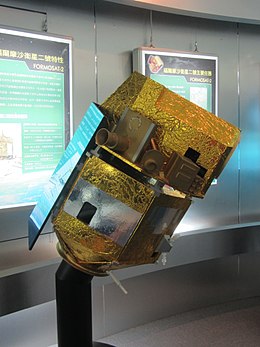Loading AI tools
From Wikipedia, the free encyclopedia
Formosat-2 (Chinese: 福爾摩沙衛星二號, formerly known as ROCSAT-2) is a decommissioned Earth observation satellite formerly operated by the National Space Organization (NSPO) of Taiwan. It was a high-resolution photographic surveillance satellite with a daily revisit capability.[3] Images are commercially available from Astrium (formerly Spot Image).
 The model of Formosat-2 | |
| Names | ROCSAT-2 |
|---|---|
| Mission type | Earth observation |
| Operator | NSPO |
| COSPAR ID | 2004-018A |
| SATCAT no. | 28254 |
| Mission duration | 12 years |
| Spacecraft properties | |
| Manufacturer | NSPO |
| Launch mass | 750 kg (1,650 lb)[1] |
| Start of mission | |
| Launch date | 19 May 2004 17:47 UTC[1] |
| Rocket | Taurus XL |
| Launch site | Vandenberg Air Force Base |
| End of mission | |
| Deactivated | 19 August 2016[2] |
| Orbital parameters | |
| Reference system | Geocentric |
| Regime | Sun-synchronous |
Formosat-2 was launched on 19 May 2004, 17:47 UTC from Vandenberg Air Force Base aboard a Taurus XL rocket.[1] It had been delivered to the United States in December 2003, and had a scheduled launch date on 17 January 2004.[4] The launch was continually delayed until May 2004.[5][6] Formosat-2 was decommissioned in August 2016.[2]
Seamless Wikipedia browsing. On steroids.
Every time you click a link to Wikipedia, Wiktionary or Wikiquote in your browser's search results, it will show the modern Wikiwand interface.
Wikiwand extension is a five stars, simple, with minimum permission required to keep your browsing private, safe and transparent.